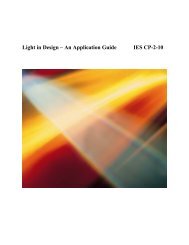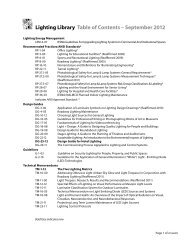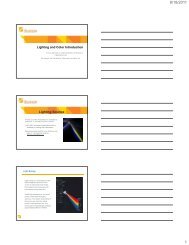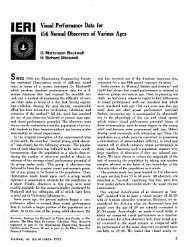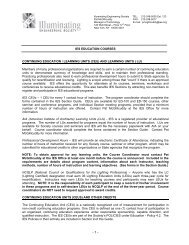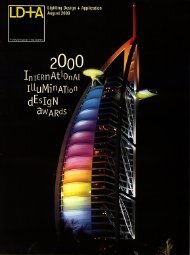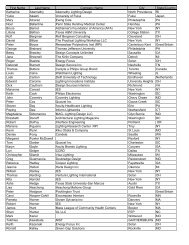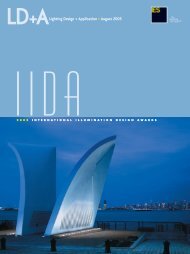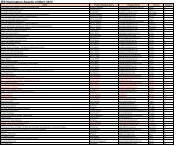RESEARCHRECAPJohn VanDerlofske,LightingResearchCenter,RensselaerPolytechnicInstituteHow important are headlamps?Although the answeris obvious, most people donot immediately realize that vehicleforward lighting is crucial tonighttime driving. Headlamps allowus to drive at night. Over the years,advances in headlamps have led tosafer and more comfortable driving.Specifications and standards havealso been developed to ensure thatdrivers can perform the necessaryvisual t<strong>as</strong>ks <strong>as</strong> well <strong>as</strong> possible.However, driving at night can stillbe dangerous. While only approximatelyone quarter of the total distancedriven in the United States isdriven at night, the total accidentrate for that time period is roughly44 percent. 1 Although other factorssuch <strong>as</strong> alcohol use and fatigue<strong>as</strong>suredly play a role in thehigher likelihood of nighttime accidents,diminished visual performancedue to reduced light levelsis also a major contributor.When developing new headlampsto improve safety, there is always abalancing act between maximizingthe visual performance of the driverand minimizing glare to oncomingdrivers. This struggle is acutely evidentwhen new lamp sources ordesigns are being introduced, suchis currently the c<strong>as</strong>e with high intensitydischarge (HID) headlamps.Why change?In fact for many years headlampdesign and technology did notchange. Sealed beam lamps instandard sizes and shapes (roundor rectangular) were the rule. Thegreatest shake-up during that periodoccurred in the early 1970swhen incandescent sealed beamtechnology w<strong>as</strong> replaced by halogen.Interestingly, there w<strong>as</strong> agreat furor at that time overincre<strong>as</strong>ed oncoming glare from thenew halogen sources. However,this commotion quickly went awayafter the rapid introduction of halogensealed beam headlamps into amajority of cars on the road.Today, headlamps have alsobecome styling elements thatdefine the appearance and brandidentity of a vehicle. This newemph<strong>as</strong>is on styling, combined withan incre<strong>as</strong>ing focus on greaternighttime driving safety, h<strong>as</strong> driventhe development of new headlamps.Notably among these areHID or xenon lamps. HID headlampswere developed in the early 1990sand offer several key advantagesover conventional halogen headlamps.They provide greater lightHID Headlamps:BalancingVisibility vs. Glare?output, higher luminous efficacy,incre<strong>as</strong>ed robustness and longerlife. 2 The small high-luminance arcof an HID lamp also allows moreefficient optical design capabilities.Being discharge rather than incandescentsources, HID lamps alsoproduce light with a different spectraldistribution and apparent colorthan most are familiar with.Can HID headlamps improve visualperformance?Absolutely. This is particularlytrue for off-axis or peripheral vision,which is important to hazard detection,negotiating curved roadwaysand nighttime driving comfort. Inrecent studies, HID headlampshave been shown to provide substantialbenefits to visual performancethat may lead to greaternighttime safety <strong>as</strong> compared tostandard halogen systems. 3, 4 Inthese studies HID headlamps enableddrivers to react quicker toperipheral target presentation, tosee more peripheral targets and tosee both peripheral and on-axis targetsat greater distances. Figure 1shows how HID headlamps resultsin fewer missed targets than comparablehalogen headlamps, particularlyfor those targets at largerPublisherWilliam Hanley, CAEEditorPaul TarriconeAssistant EditorRoslyn LoweAssociate EditorJohn-Michael KobesArt DirectorAnthony S. PiccoAssociate Art DirectorSamuel FontanezColumnistsEmlyn G. AltmanLouis Erhardt • Stan WalerczykWillard WarrenBook Review EditorPaulette Hebert, Ph.D.Marketing ManagerSue FoleyAdvertising CoordinatorLeslie PrestiaPublished by IESNA120 Wall Street, 17th FloorNew York, NY 10005-4001Phone: 212-248-5000Fax: 212-248-5017/18Website: http://www.iesna.orgEmail: iesna@iesna.orgLD+A is a magazine for professionals involved in the art,science, study, manufacture, teaching, and implementationof lighting. LD+A is designed to enhance andimprove the practice of lighting. Every issue of LD+Aincludes feature articles on design projects, technicalarticles on the science of illumination, new product developments,industry trends, news of the IlluminatingEngineering Society of North America, and vital informationabout the illuminating profession.Statements and opinions expressed in articles and editorialsin LD+A are the expressions of contributors anddo not necessarily represent the policies or opinions ofthe Illuminating Engineering Society of North America.Advertisements appearing in this publication are the soleresponsibility of the advertiser.LD+A (ISSN 0360-6325) is published monthly in theUnited States of America by the Illuminating EngineeringSociety of North America, 120 Wall Street, 17th Floor,New York, NY. 10005, 212-248-5000. Copyright 2003 bythe Illuminating Engineering Society of NorthAmerica. Periodicals postage paid at New York, N.Y.10005 and additional mailing offices. Nonmember subscriptions$44.00 per year. Additional $15.00 postage forsubscriptions outside the United States. Member subscriptions$32.00 (not deductible from annual dues).Additional subscriptions $44.00. Single copies $4.00,except Lighting Equipment & Accessories Directory andProgress Report issues $10.00. Authorization to reproducearticles for internal or personal use by specificclients is granted by IESNA to libraries and other usersregistered with the Copyright Clearance Center (CCC)Transactional Reporting Service, provided a fee of $2.00per copy is paid directly to CCC, 21 Congress Street,Salem, MA 01970. IESNA fee code: 0360-6325/86 $2.00.This consent does not extend to other kinds of copyingfor purposes such <strong>as</strong> general distribution, advertising orpromotion, creating new collective works, or resale.POSTMASTER: Send address changes to LD+A, 120Wall Street, 17th Floor, New York, NY 10005. Subscribers:For continuous service ple<strong>as</strong>e notify LD+A ofaddress changes at le<strong>as</strong>t 6 weeks in advance.This publication is indexed regularly by EngineeringIndex, Inc. and Applied Science & Technology Index.LD+A is available on microfilm from Proquest Informationand Learning, 800-521-0600, Ann Arbor, MI10 LD+A/May 2003 www.iesna.org
Figure 1—The percentage of missed target presentations <strong>as</strong> a function of anglefrom the line of sight. Targets were positioned at 60 m away and illuminated bytypical halogen and HID headlamps.angles from the drivers’ line ofsight. 3As far <strong>as</strong> peripheral visual performanceis concerned HID lamps differfrom conventional halogen headlampsin two important <strong>as</strong>pects:total light output and spectral composition.It is the first of these, moretotal light output (HID lamps produce2-3 times more light than traditionalhalogen sources), that isprobably the primary factor in theincre<strong>as</strong>e in performance. Greatertarget illuminance results in incre<strong>as</strong>edperformance.Why would this be particularlytrue at the edge of the beam?Wouldn’t the extra light be distributedevenly through the beam pattern?Regulations for headlampshave strict requirements for distributionin the central part of the headlampbeam, which tends to makethese central portions very similar,regardless of source type. The lightdistribution at the edge of the headlampbeam pattern, however, is not<strong>as</strong> well regulated. Therefore theextra light produced by HID sourcesoften ends up in the periphery, resultingin a wider beam and improvedperipheral visual performance.Although target illuminance andtherefore beam pattern is arguablythe most important factor whenconsidering headlamp visual performancethe role of light spectralcomposition cannot be entirelyoverlooked. Another recent studyw<strong>as</strong> performed to determine therole that HID lamp spectrum playson visual performance. 5 This studyoffers evidence that HID lamp spectracan produce small but me<strong>as</strong>urableimprovements over halogensystems for off-axis visual performance.The exact magnitude ofthese differences depends on theoff-axis angle, the light level and thetarget contr<strong>as</strong>t.Do HID headlamp systems producemore glare?It depends on how glare isdefined. Generally, two types of glareare recognized: discomfort glareand disability glare. Disability glareis defined by the direct reduction ofvisual performance. Light from glaresources get scattered in the eye andis perceived <strong>as</strong> a luminous veil overthe scene. This veil reduces the contr<strong>as</strong>tof objects and hence their visibility.Discomfort glare is a sensationof annoyance or distraction thatis often me<strong>as</strong>ured by means of <strong>as</strong>ubjective rating scale. Discomfortglare does not necessarily impairthe visibility of objects.Recent studies have shown whileHID lamps do not result in any incre<strong>as</strong>eddisability glare they do resultin a significant incre<strong>as</strong>e in discomfortglare. 6,7 That is, for thesame illuminance at the eye, HIDheadlamps do not directly reducevisual performance any more thantraditional halogen sources, butthey do produce a greater feeling ofdiscomfort. Disability glare is generallyme<strong>as</strong>ured by foveal or on-axisperformance, which follows thestandard photopic (cone) spectralresponse. Therefore, for equal illuminanceat the eye you wouldexpect equal disability glare.Discomfort glare, however, doesnot seem to follow a photopicspectral response or even a scotopic(rod) response. In fact, littleis known about the b<strong>as</strong>ic mechanismsbehind discomfort glare orits spectral response. It does seemthe short wavelength or “blue”content of a light source affectsthe discomfort glare it produces,with greater short wavelengthenergy resulting in more discomfortglare. HID headlamp sourceshave more energy than halogenlamps in the short wavelengthregion of the visible spectrum.Current research is trying to determinethe exact spectral responsefunction for discomfort glare. It isinteresting that even thoughimproved peripheral vision and discomfortglare both depend onspectral content, and both appearto incre<strong>as</strong>e with more energy inthe short visible wavelengths, thetwo responses are not the same.That is, incre<strong>as</strong>ed visual performanceat low light levels does nothave to mean more glare.Note, however, that even thoughdiscomfort glare does not directlyimpact visual performance it doesnot mean that it is not important.Discomfort glare can indirectlyaffect performance by causing a driverto look away from an area of theroadway that should be paid attentionto or by otherwise adverselyaffecting behavior. Prolonged exposureto high levels of discomfortglare may also have effects overtime and could possibly lead togreater fatigue.Can visibility and glare be balancedfor HID headlamps?Yes. However, there is no singlesolution to this challenge. Automotivelighting designers will continueto struggle to balance the visualbenefits and potential drawbacks ofHID headlamps, at le<strong>as</strong>t in the nearfuture. This w<strong>as</strong> the c<strong>as</strong>e in the p<strong>as</strong>tfor sealed beam halogen lamps andwill be in the future for other newheadlamp sources, such <strong>as</strong> whiteLEDs. Advances will take place insource design, optical design, beamshaping and system intelligencethat will all contribute to optimizedsystems. However, research will bethe key in this process to definingwhere the balance point should beand how to strike it. For example,determining the exact spectral12 LD+A/May 2003 www.iesna.org



